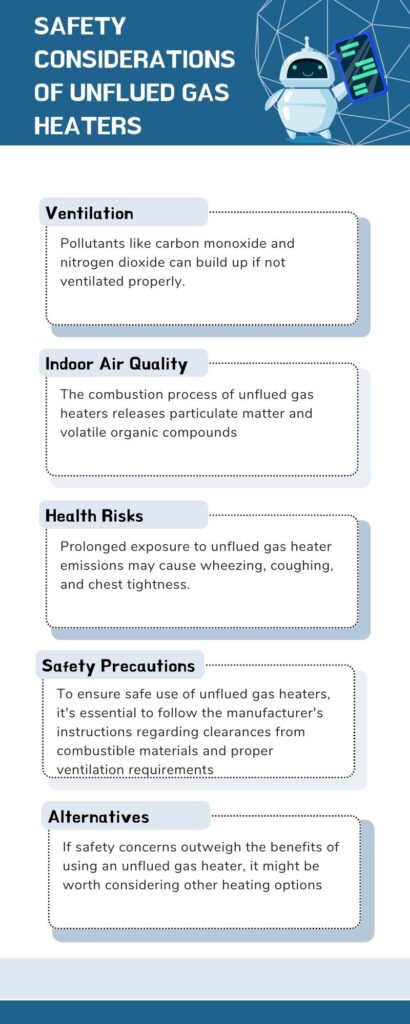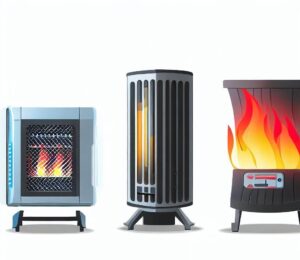Table of Contents
Unflued gas heaters don’t have flues – those pipes and ducts for venting exhaust gases. So the emissions from the heater stay in the room. This can be bad for health. Studies show exposure to emissions can lead to wheezing, coughing, chest tightness, and shortness of breath – particularly for kids and people with asthma.
One big fear is carbon monoxide – an odourless, colourless gas that can be deadly. Unflued gas heaters can also release nitrogen dioxide and formaldehyde. Plus, lack of ventilation can mean a build-up of these toxic gases.

Humidity levels can also increase, creating a good environment for mold and allergens. To stay safe it’s important to make sure there’s proper ventilation. Regular maintenance of the heating system is also recommended – and be aware of any symptoms related to unflued gas heaters.
What is an unflued gas heater?
Unflued gas heaters are known for their convenience and affordability. But, they release all combustion gases into the room, leading to a buildup of pollutants like carbon monoxide and nitrogen dioxide. This can cause respiratory symptoms like coughing and wheezing.
Studies have linked exposure to unflued gas heaters to respiratory problems, especially in those with pre-existing conditions. To stay safe, it’s important to follow ventilation guidelines and regularly service the heater. And, consider alternative heating options that won’t harm the air quality.
Key Notes
- Unflued gas heaters are a type of gas heater that do not have a flue or chimney to vent the combustion gases outside.
- These heaters release combustion byproducts, such as carbon monoxide and nitrogen dioxide, directly into the room where they are being used.
- The release of these gases can lead to poor indoor air quality and potential health risks, especially in poorly ventilated spaces.
- It is important to ensure proper ventilation when using an unflued gas heater to minimize the buildup of these harmful gases.
- Regular maintenance and servicing of unflued gas heaters is crucial to ensure their safe and efficient operation.
- It is recommended to use alternative heating options, such as flued gas heaters or electric heaters, which do not release combustion gases into the room.
Understanding the difference between flued and unflued gas heaters
Flued and unflued gas heaters have different features. Let’s compare them in the table below:
| Flued Gas Heaters | Unflued Gas Heaters |
|---|---|
| Exhaust gases expelled outside via a flue or chimney | Releases exhaust gases into the room |
| Needs professional installation | Can be installed without help |
| More efficient due to external ventilation | Lower energy efficiency due to lost heat |
| Regular maintenance & cleaning of the flue/chimney | Minimal maintenance & cleaning |
| Improved indoor air quality | Decreased air quality due to combustion products |
We must remember safety first, when considering unflued gas heaters. Combustion products like carbon monoxide and nitrogen dioxide can cause respiratory problems, particularly in people with asthma.
To stay safe, do these things:
- Ventilate the room where the heater is. Open windows or doors to let in fresh air.
- Get a qualified professional to assess if the space is suitable for an unflued heater.
- Have it serviced and maintained regularly.
- Install a carbon monoxide detector in the room.
- Limit the use of unflued gas heaters. Use flued gas heaters or electric heating where possible.
By following these steps, you can ensure a safe and healthy environment for your family. Enjoy your warmth with no asphyxiation!
Safety considerations of unflued gas heaters
Unflued gas heaters can be a popular choice for home heating. But it’s important to think about their safety implications. Here are some key points to bear in mind:
- Ventilation: Unflued gas heaters release combustion gases directly into the room. Pollutants like carbon monoxide and nitrogen dioxide can build up if not ventilated properly.
- Indoor Air Quality: The combustion process of unflued gas heaters releases particulate matter and volatile organic compounds. These pollutants can affect respiratory health, especially in those with asthma or other respiratory conditions.
- Health Risks: Prolonged exposure to unflued gas heater emissions may cause wheezing, coughing, and chest tightness. Also, it might increase the prevalence and severity of asthma symptoms.
- Safety Precautions: To ensure safe use of unflued gas heaters, it’s essential to follow the manufacturer’s instructions regarding clearances from combustible materials and proper ventilation requirements. Qualified professionals should do regular inspections and maintenance.
- Alternatives: If safety concerns outweigh the benefits of using an unflued gas heater, it might be worth considering other heating options such as flued gas heaters, electric heaters, or heat pumps.
Individual circumstances may vary. Consult a professional before deciding on an unflued gas heater. This will help address safety concerns and ensure a safe environment for all occupants.

A family in Sydney had an unflued gas heater in their living room during winter without knowing the potential risks. They started to experience headaches, dizziness, and respiratory issues. Investigation revealed that the heater was emitting high levels of carbon monoxide due to lack of ventilation. This story serves as a reminder to prioritize safety when using unflued gas heaters. Seek professional advice for proper installation and maintenance.
Benefits and drawbacks of unflued gas heaters
Unflued gas heaters have benefits and drawbacks to think about. Here’s a quick look:
- High efficiency with no flue or chimney needed.
- Easy to transport from room to room.
- Lower installation costs.
- Good ventilation is key.
- Pollutants created can cause problems.
Remember that ventilation and potential health risks must be taken into account when using unflued gas heaters. To stay safe, follow instructions and keep rooms well-ventilated.
Tips for using unflued gas heaters safely
Using an unflued gas heater safely is essential for individuals’ health. Here are some tips:
- Ventilate the room where the heater is used. Open a window or door to let in fresh air and reduce pollutant concentration.
- Don’t use the heater in small, poorly ventilated spaces, like bedrooms. Air needs to circulate.
- Take breaks and switch off the heater from time to time to lessen exposure to combustion byproducts.
- Keep kids and pets away. They may touch hot surfaces or get respiratory issues from indoor pollutants.
- Service and clean regularly for efficient operation and to reduce airborne pollutants.
- If you feel dizziness, headaches, or respiratory discomfort, immediately turn off the heater and seek professional help.
Remember to consider other heating options, like flued gas heaters or electric heaters. Gas heaters can be like a controlled fire or a flame-thrower.
Comparison with other types of heaters
Unflued gas heaters are unique from other heaters. Let’s compare them using this table:
| Heater Type | Fuel Type | Ventilation Required | Indoor Air Quality Impact | Safety Concerns |
|---|---|---|---|---|
| Unflued Gas Heater | Natural Gas / LPG | Minimal ventilation needed | May contain air pollutants, like nitrogen dioxide and carbon monoxide, if not maintained or used with enough fresh air. | Safety risks due to combustion byproducts in the air. Maintenance and installation are key to minimize these risks. |
| Flued Gas Heater | Natural Gas / LPG | Requires flue or chimney | Less impact on air quality than unflued gas heaters | Safer as combustion byproducts are vented outside |
| Electric Heater | Electricity | No ventilation needed; no emissions | Doesn’t affect air quality negatively | Avoids contributing to air pollution and improves air quality. |
It’s also important to note that unflued gas heaters don’t need a flue or chimney. This makes them more portable and easier to place.

Here’s an interesting story. A friend of mine got a new apartment and bought an unflued gas heater for their living room. After a while, they experienced coughing and chest tightness. They consulted a professional who warned them of indoor air pollutants from unflued gas heaters. So, they changed to a flued gas heater. This improved their air quality and their respiratory symptoms.
When looking at different heaters, think about safety and air quality. Choosing the right heater for your space can make a big difference for comfort and health.
Frequently Asked Questions
FAQs about Unflued Gas Heaters:
Q1. What does unflued gas heater mean?
A1. An unflued gas heater is a type of gas heater that does not have a flue or chimney to vent out the combustion gases. Instead, it releases the gases directly into the room.
Q2. What is the difference between a flued and unflued gas heater?
A2. The main difference is that a flued gas heater has a flue or chimney to vent out the combustion gases, while an unflued gas heater releases the gases directly into the room. Flued heaters are considered safer as they remove the potentially harmful gases from the indoor environment.
Q3. Is an unflued gas heater safe to use?
A3. Unflued gas heaters can pose some risks if not used properly. The combustion gases, such as carbon monoxide, nitrogen dioxide, and moisture, can accumulate indoors, causing respiratory symptoms and other health issues. It is important to ensure proper ventilation and follow safety guidelines when using an unflued gas heater.
Q4. Are unflued gas heaters banned?
A4. Unflued gas heaters are not banned in most countries, but there may be regulations and guidelines in place to ensure their safe use. It is recommended to check with local authorities to understand the specific regulations in your area.
Q5. What are the ventilation requirements for an unflued gas heater?
A5. Unflued gas heaters require adequate ventilation to minimize the accumulation of combustion gases. This can include opening windows or using a ventilation system to ensure a constant supply of fresh air. It is important to follow the manufacturer’s instructions and local guidelines for proper ventilation.
Q6. Are unflued gas heaters suitable for indoor use?
A6. Unflued gas heaters can be used indoors, but proper precautions should be taken. Adequate ventilation, regular maintenance, and following safety guidelines are crucial to minimize the risks associated with unflued gas heaters.
Conclusion
Troubling findings were uncovered in a study on unflued gas heaters and respiratory health. Students in New South Wales schools served as the population for the study. An obvious link was established between unflued gas heater use and respiratory symptoms.
Air pollutants like NO2, CO, and formaldehyde were higher in classrooms with unflued gas heaters than those with flued gas fireplaces. These gases can cause respiration issues and worsen conditions like asthma.
Plus, exposure to unflued gas heaters was linked to increased wheezing, coughing, and chest tightness. Young children and those with atopic status are especially vulnerable to these effects. Even a one-week study period had a noteworthy impact on lung function measurements.
The results of the study underline the importance of proper ventilation when using unflued gas heaters. People with respiratory conditions or young children should be cognizant of the dangers associated with these heaters. To protect their health, look into other heating options or make sure there is adequate fresh air when using these types of heaters
